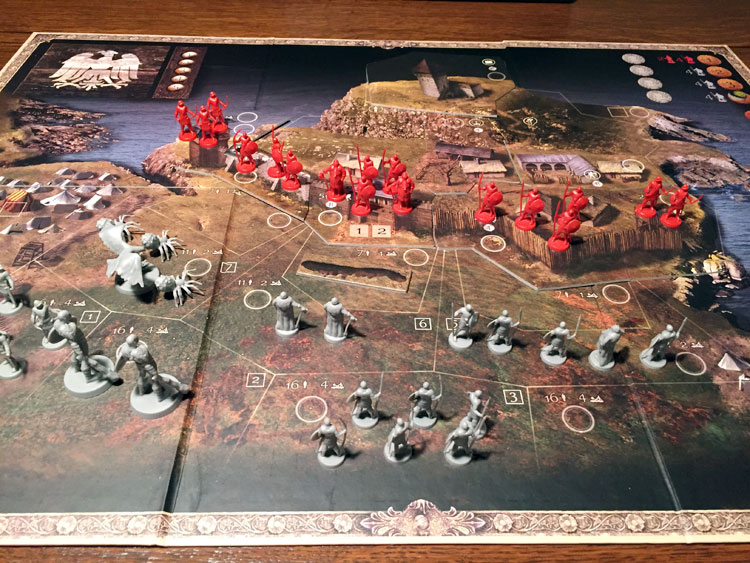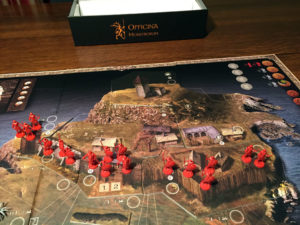 Board games based around the siege of a castle are a great concept. I think what intrigues me the most is the asymmetrical nature of the combat. The defender must turtle up and try to hold off an usually overwhelming force, while the attacker needs to break the walls. It’s the classic unstoppable force meets the immovable object scenario.
Board games based around the siege of a castle are a great concept. I think what intrigues me the most is the asymmetrical nature of the combat. The defender must turtle up and try to hold off an usually overwhelming force, while the attacker needs to break the walls. It’s the classic unstoppable force meets the immovable object scenario.
Today we are going to take a look at a game called The Exiled: Siege, which was funded on kickstarter near the end of 2015. Having delivered to its backers, we’ve had a chance to put it through the paces and are ready to see how well it holds up.
The Exiled: Siege is a war game for 1-5 players that takes about 90-120 minutes to play. The Exiled: Siege plays best with 2 players.
Game Overview:
In The Exiled: Siege, one player takes on the role of the attacker trying to bring his invading force of fantasy-themed armies to bear on the defenders of the castle. When there are more than two players, the extra players share the role of defender.
Each game, the attackers and defenders will spend time building up their fortifications (or army camp for the attacker) and armies, and then conduct a series of attack rounds. The goal for the attacker is to damage the defenders walls (and then city), while the defender just needs to hold out until time expires.
Game Components:

The game components in The Exiled: Siege have their ups and downs. The best part about the game has to be the castle components, which fit together in a puzzle-like nature (more on this later).
Thanks to its Kickstarter stretch goals, wooden cubes in the game were replaced with plastic miniatures. While the quality on these are not very good, I do like them better than the original wooden cubes (which I abhor in games), so I can’t complain too much.
The game also comes with a few decks of cards: building, attack, special and reaction cards. There are decks for both the attacker and defender, with some cards being used in a few different ways.
Finally, the game’s rulebook. While not horrible, it could have been organized and proofed a bit better. There were quite a few typo-s in it and some rules weren’t as clear as they could be. That being said, I didn’t really have any trouble learning the game from it, and plenty of examples were provided.
How to Play:
I’m going to give you a high level overview of how The Exiled: Siege was played. For the full rules, you can download a PDF here.
Once the board is setup and the various decks are prepared, you’re ready to begin. Each game of The Exiled: Siege takes place over up to 4 rounds, with each round being divided into 2 stages:

Development Stage:
This stage begins by the attacker and defender taking their respective development decks and sorting it into a priority order. Each deck will have a number of cards to improve the players position in the game. Most cards allow a player to build structures (or walls), recruit troops, siege machines or monsters (in the case of the attacker), and repair damage. There are also a few special cards unique to each player.
The key here is that the attacker sets the time limit. Wherever the attacker positions the “assault” card into their build stack, that signifies when the development stage ends. The defender won’t know where that card is placed, so they will have to be sure to prioritize their cards.
Once both players are ready, they each take turns revealing cards one at a time and executing the specific actions. Some actions might take multiple cards to resolve. Once the assault card is revealed, the development stage ends.
Siege Stage:
In the Siege stage, players first deploy any troops they recruited in the development stage (minding stacking limits). Players then choose their starting hand of orders, special and reaction cards, with the remainders being formed into draw piles.
Starting with the defender, players alternate playing order cards from their hand. These will usually activate one group of units on the board. Units can usually move or attack. However once activated, they are exhausted for the round. Players initially start the game with just a few simple attack cards. But as they construct advanced buildings in the development stage, more unique cards are added to their available options.
Combat is simple. The attacker totals their unit’s strength, draws an efficiency card (which will usually modify their attack value + or – 1) and applies damage to the defending units. Surviving units get to attack back. If the assaulting player destroys every unit on a wall section, they damage the city. Damage the city enough times, and the attacker wins.
The siege stage is divided into 4 rounds of combat and reorganization (cleanup), but may end sooner if all the attackers troops have been killed.
After the siege stage has concluded, players begin the next round with another development stage. The game ends as soon as the attacker does enough damage to the city, or at the end of the 4th siege stage (with a defender win).

Game Experience:
In case it isn’t clear from my brief overview of how to play the game, there is a lot going on in The Exiled: Siege. From learning what each type of building does, to fighting out the best way to use each troop, The Exiled: Siege definitely has a learning curve.
However I’m not very surprised by the steep learning curve in this game. Most asymmetrical games will have one, as players can’t learn things by watching their opponents’ turns. Expect it to take at least a game or so before you can really feel comfortable playing the game. I also think that the attacker has an easier role, so I’d give that to new players.
However, you can definitely expect players to fumble their way through their first game (we did). The poorly laid out rulebook, combined with the information overload of trying to figure out what everything does, may turn off players after their first game. But players willing to stick with The Exiled: Siege through its learning curve can actually have a decent amount of fun with the game.

I must say, it’s a bit silly but one of my absolute favorite parts of the game is building the defenders castle. There is something incredibly satisfying about watching it come together as you build/upgrade each piece. The artwork matches from section to section and players get the satisfaction and joy felt at completing a puzzle once it’s done. I wish more games would take their approach with their components.
One of the more interesting aspects of The Exiled: Siege is how the combat decks are built. When an attacker or defender constructs a new building, the main thing it does is unlock new cards that are added to your siege stage decks. This gives the game almost a bit of a deck building feel to it. It also makes the game a tad easier to learn as players can safely ignore cards for buildings that they haven’t made yet and can ease themselves into the first siege stage. I also really enjoyed how the attacker set the timer for the round with their assault card. I found this to be a really thematic way to designing the development stage.
The Exiled: Siege also offers options for solo gaming. While I rarely engage in solo games, usually preferring to just play a video game when I’m by myself, I did try out a few of the solo missions. When playing solo (or wanting to play purely cooperative), the game gives players a defender scenario they must try and survive. There are about 10 in total for the players to wade through and I thought it was a great idea to include these. The scenarios have an almost puzzle-like feel to them as most of the information is visible ahead of time (other than some random timing mechanisms.)

While we are on player scaling, I do have to say that this game is not really a game for more than 2 players. The box says 1-5 players, but you can probably ignore that. It’s a two player game that carves up the defender role for more players. While it works, it’s clearly added on after the fact as the defenders don’t share their role in any meaningful way. Instead of 1 player selection 12 development cards, 4 players would choose 3 each. Meh.
Finally, one last thing I liked about The Exiled: Siege was that there are clearly many paths to victory. Each player controls their strategy through the buildings the construct. The attacker can go tech with lots of siege weapons, or skip that entirely and breed armies of monsters. The defender can build lots of thick walls, or opt for other buildings to give them lots of special powers. I liked how the game is clearly not scripted.
Final Thoughts:
I had a bit of a bumpy start trying to play The Exiled: Siege. It’s steep learning curve, combined with the difficultly of looking up rules questions started to turn me off the game. However I’m glad I stuck with it. Once I got a feel for the game, I enjoyed the unique mechanics and open play style.
This type of game isn’t going to be for everyone, but for those looking for a fun, asymmetrical two player (This game is really only for 1-2 players), then The Exiled: Siege is worth a look. While the components aren’t going to wow anyone, it does a good job of pulling players into the middle of a siege.
If you’d like to get a copy of The Exiled: Siege, you can pick it up for about $75.
Final Score: 3.5 Stars – Once you get past its learning curve, you can have a lot of fun with this asymmetrical game.
 Hits:
Hits:
• Building the caste is so fun
• Unique mechanics
• Many paths to victory
Misses:
• Learning curve a bit steep
• Rulebook could be better
• Not for more than 2 players
























How would you compare the game to the other classic siege game: Stronghold?
I haven’t played Stronghold in quite a long time, but from what I remember, they actually play fairly differently. Exiled is a bit more tactical, with the combat rounds being a bit more action oriented. You also get to build out your stronghold as the game progresses in The Exiled. Finally, I found Exiled to be a lot more forgiving to the Defender then Stronghold. In Stronghold, one breach ends the game, while The Exiled gives you 4 chances.